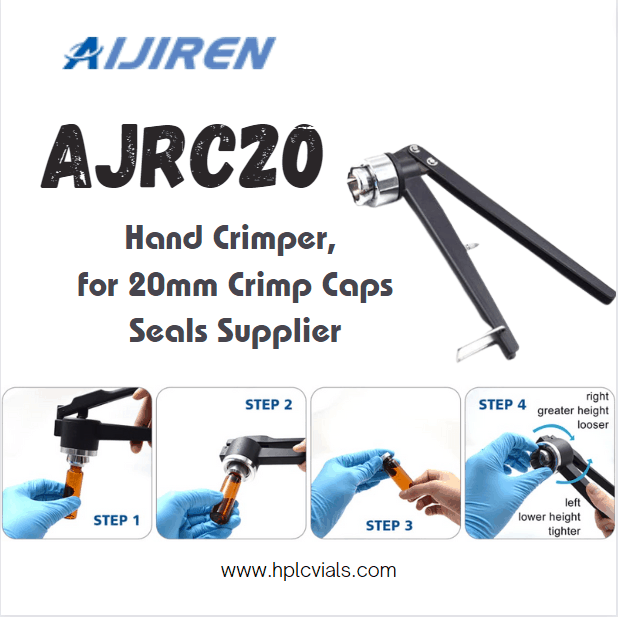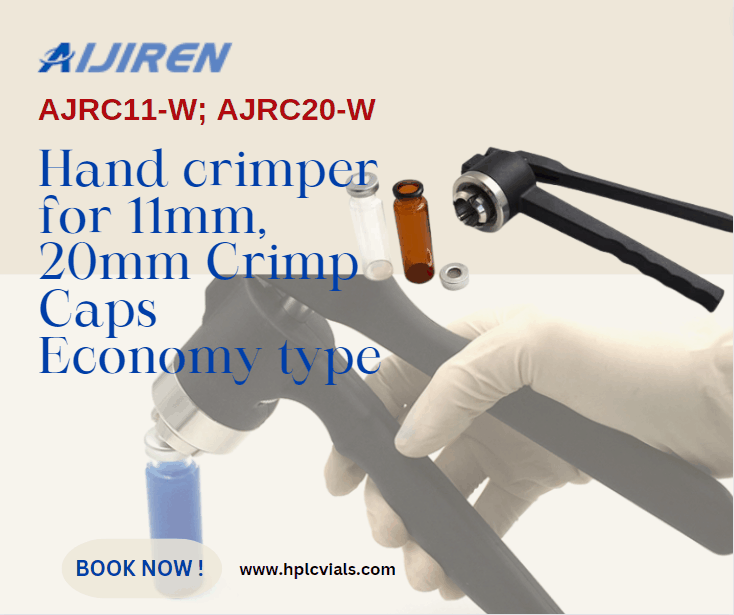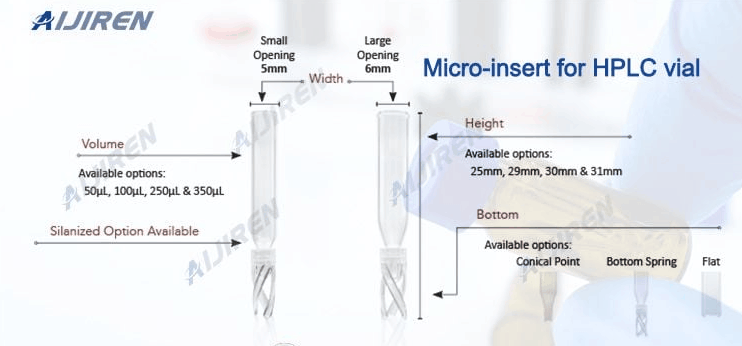By considering these factors, you can select a vial crimper that aligns with your laboratory's needs and ensures consistent, accurate, and contamination-free sample sealing. Taking the time to choose the right vial crimper will contribute to the overall quality of your analytical processes and research outcomes.
Unlock comprehensive insights on PTFE/Silicone septa. Explore this informative article for a complete understanding of their properties and applications:Premium PTFE and Silicone Septa: Reliable Sealing Solutions
How to use the vial crimper Steps
Using a vial crimper involves a series of steps to ensure proper sealing of vials. Follow these guidelines to effectively use a vial crimper:
1.Preparation:
Prepare your sample and ensure it's properly filled in the vial.
Place the appropriate cap on the vial's neck. The cap should fit snugly and securely.
2.Positioning:
Place the vial with the cap on the vial crimper's platform.
Make sure the vial is aligned with the crimper's head for accurate sealing.
3.Alignment:
Align the crimper's head directly above the cap and vial's neck.
Ensure the aluminum seal is positioned properly on top of the cap.
4.Pressure Application:
Depending on the type of vial crimper:
Manual Crimper: Apply even and steady downward pressure on the crimper's handle to initiate the crimping process.
Automatic or Electric Crimper: Press the designated button or activate the motor to begin the crimping process.
Pneumatic Crimper: Activate the air pressure to apply controlled force for crimping.
5.Crimping:
As pressure is applied, the vial crimper's mechanism will fold the aluminum seal over the cap and vial's neck.
The folding process creates a secure and uniform seal that prevents the cap from coming loose.
6.Completion:
Release the pressure mechanism once the crimping process is complete.
Lift the vial from the crimper's platform.
7.Inspection:
Carefully inspect the sealed vial to ensure the aluminum seal is securely crimped.
Check for any signs of uneven or incomplete crimping.
8.Quality Control:
For assurance, conduct a visual inspection of multiple sealed vials to confirm consistent and reliable seals.
9.Record Keeping:
Maintain proper documentation of the crimped vials, including sample information and crimping date.
Remember these 6 key points when using a vial crimper:
1.Apply even pressure to ensure uniform sealing without damaging the cap or vial.
2.Ensure that the aluminum seal is correctly positioned before crimping.
3.Avoid over-crimping, which may lead to deformation of the cap or vial.
4.Perform the crimping process on a clean and stable surface.
5.If using a manual crimper, ensure proper hand placement to exert even pressure.
6.By following these steps, you can effectively use a vial crimper to create reliable and airtight seals, ensuring the integrity of your valuable samples for accurate analysis.

Common Challenges and Troubleshooting of Vials Crimpers
Using vial crimpers for sealing samples can sometimes pose challenges that affect the integrity of the seals. Here are some common challenges and troubleshooting tips to address them:
1.Uneven Crimping:
Issue: The aluminum seal is not uniformly folded over the cap, leading to an uneven or partial seal.
Troubleshooting: Ensure proper alignment of the vial, cap, and crimper's head. Apply even pressure during the crimping process. Inspect the crimping head for any damage or misalignment.
2.Compromised Seal Integrity:
Issue: The seal isn't secure, and the cap may come loose, leading to sample contamination.
Troubleshooting: Check if the cap is properly positioned on the vial's neck before crimping. Ensure that the aluminum seal covers the entire cap. Adjust crimping force if needed to achieve a tighter seal.
3.Sample Loss:
Issue: Excessive pressure during crimping can cause sample loss due to leakage or evaporation.
Troubleshooting: Be cautious while applying pressure. If using a manual crimper, ensure controlled pressure. Consider using an adjustable crimper to prevent over-crimping.
4.Damaged Caps:
Issue: Caps may get damaged or deformed during the crimping process.
Troubleshooting: Ensure that the caps are compatible with the vial and crimper. Adjust crimping force if needed to prevent damage. Inspect the caps for defects before use.
5.Inconsistent Seals:
Issue: Seals may vary in tightness and appearance across different vials.
Troubleshooting: Maintain consistent pressure during the crimping process. Check if the crimping head is properly aligned and in good condition. Calibrate the crimper if necessary.
6.Sample Contamination:
Issue: External contaminants may enter the vial if the seal isn't airtight.
Troubleshooting: Verify that the aluminum seal is properly positioned and covers the cap completely. Ensure the cap fits securely on the vial's neck.
7.Crimper Maintenance:
Issue: Over time, crimpers may experience wear and tear, affecting their performance.
Troubleshooting: Regularly clean and lubricate the crimper to ensure smooth operation. Replace worn or damaged crimping heads. Perform routine maintenance as recommended by the manufacturer.
8.Incorrect Crimping Head:
Issue: Using the wrong crimping head for the cap size can lead to improper seals.
Troubleshooting: Ensure the crimping head matches the cap size. Use interchangeable heads designed for the specific vial and cap dimensions.
9.Operator Technique:
Issue: Inexperienced or inconsistent operators may lead to sealing inconsistencies.
Troubleshooting: Train operators on proper crimping techniques. Provide guidance on pressure application and alignment. Monitor the crimping process for quality control.
10.Equipment Quality:
Issue: Low-quality crimpers may result in poor seals and unreliable analysis results.
Troubleshooting: Invest in high-quality vial crimpers from reputable manufacturers. Research customer reviews and seek recommendations to ensure reliable equipment.
Addressing these common challenges and troubleshooting effectively will help you achieve consistent and secure seals using vial crimpers, ensuring the integrity of your samples and accurate analytical outcomes.
Delve into a comprehensive article addressing the 50 most common HPLC vials questions. Unlock insights and answers for informed decisions:50 Most Frequently Asked Questions on HPLC Vials

 English
English
 Chinese
Chinese










